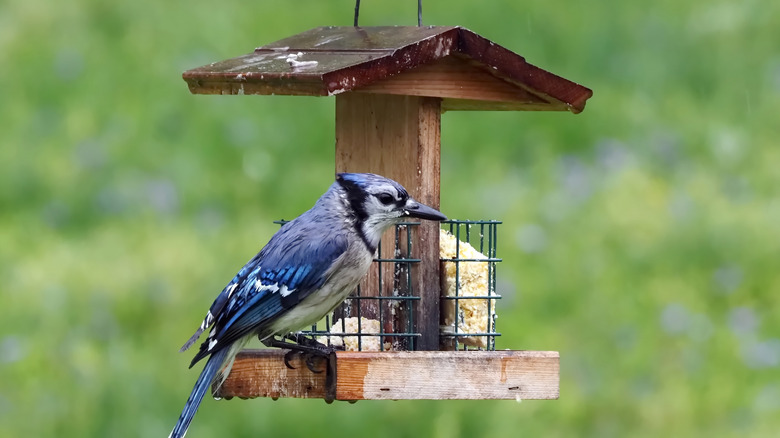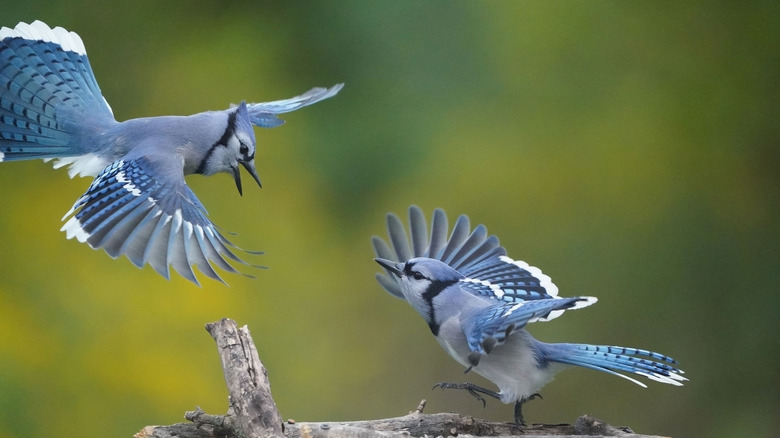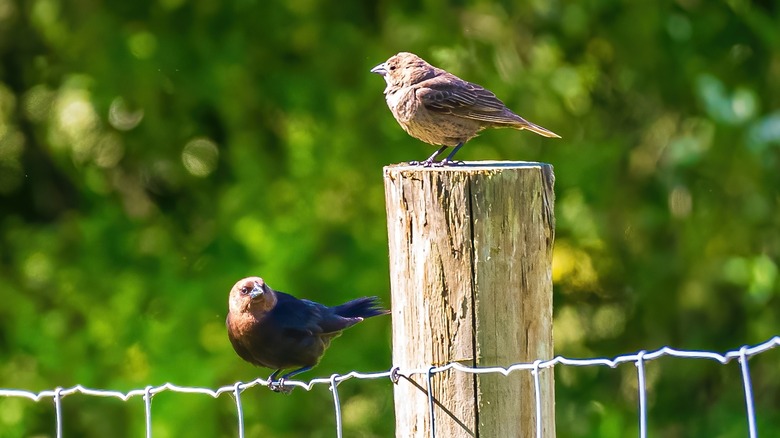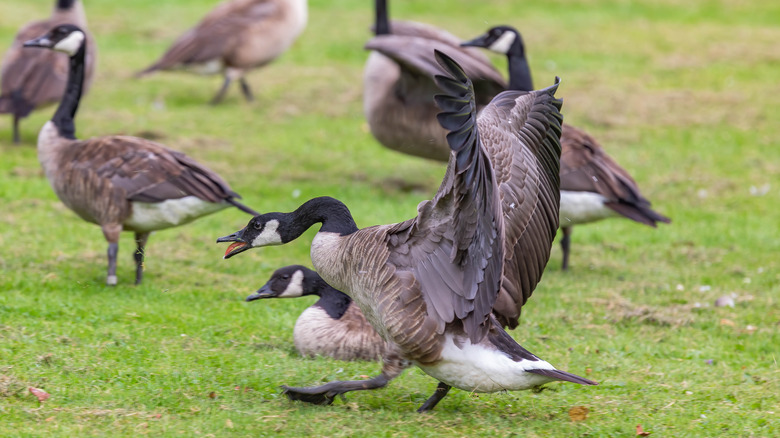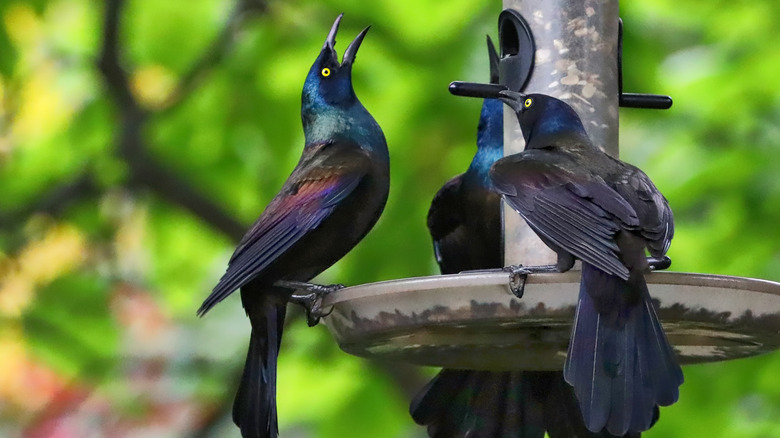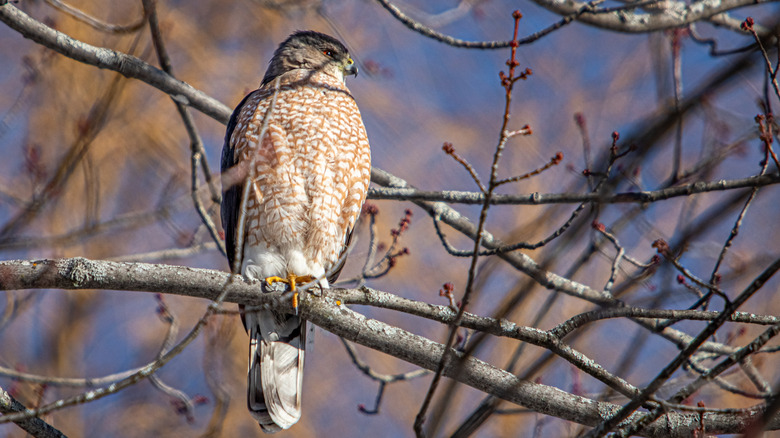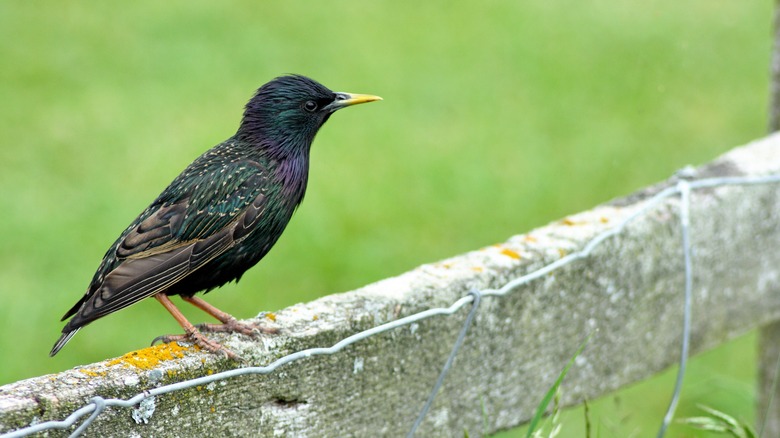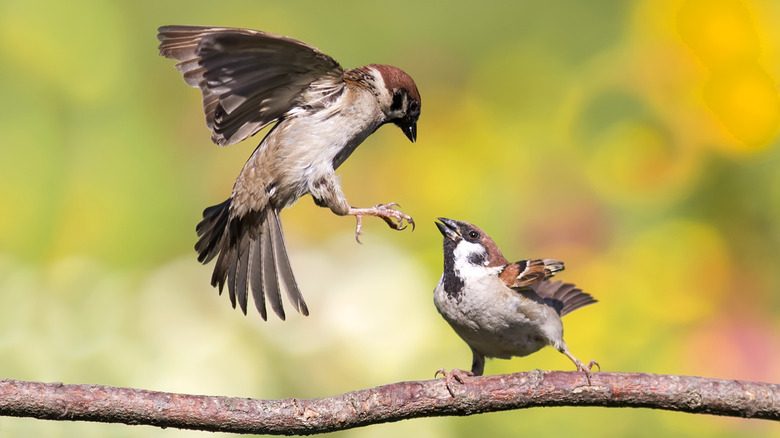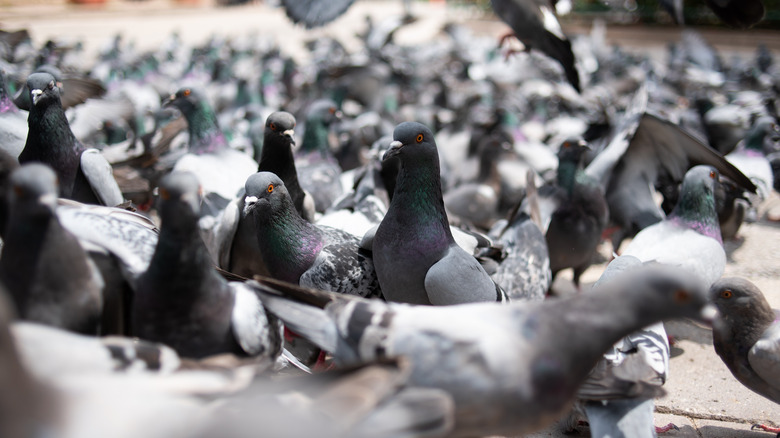9 Birds You Do Not Want To See In Your Yard
The business of backyard birding is a $5 billion per year industry, so it's clear we can say that a lot of us really love attracting birds to our yards. Here at House Digest, we do too, and it pains us to pick on any of them, but unfortunately, some species are a little too gregarious and aggressive to live peacefully alongside the other residents. They might bully smaller and weaker songbirds away from the feeder, or in some cases, away from their own nests. There are birds known to carry and spread diseases that can affect humans, household pets, and the other fauna throughout our neighborhoods. And some of them simply won't shut up as they wreak absolute havoc on our lawns and gardens.
That said, over 1,000 species (almost all native birds in the U.S.) are protected via the Migratory Bird Treaty Act of 1918, and we would never condone extreme, illegal, or violent measures to deter any wildlife from your property. But with a little education on what to look out for as well as how to go about preventing and deterring unwanted inhabitants, we're confident all of us can learn to get along.
Blue jays
Jays, and blue jays specifically, are polarizing birds. Some avian enthusiasts love them, while others love to hate them. They're known to be territorial to a fault and shockingly loud. Blue jays can make such an obnoxious racket they scare away hawks and owls, which they do intentionally so that they get the opportunity to attack the smaller birds like chickadees and titmice instead.
Jays are not birds of prey, but they aggressively fight small birds over territory and food, occasionally stealing an egg or two, and they will mount an indefatigable defense if they ever sense that their little fledglings are in danger. And can we blame them? Whether it's survival of the fittest or a nuisance is for individual homeowner to decide.
To cut back on the number of stunning blue visitors to your yard and to give other birds a chance to eat, you might try switching up the seeds in your bird feeder. For example, jays dislike nyjer thistle seeds but finches love them. You could also try startling them away with owl decoys and reflective surfaces. Clanking metal wind chimes might beat them in the noise game too. Try making a unique wind chime with items from your junk drawer.
Brown-headed cowbirds
Brown-headed cowbirds are known for their peculiar behavior in regard to where females lay eggs. As brood parasites, they seek out nests where different species of birds have laid eggs, and when those birds fly off to find food, they swoop in and lay eggs in the same nest. To make matters worse, they will often remove and destroy one of the existing eggs to make room for their own. When the other bird returns to its nest it has no idea that it has been forced into becoming a foster parent for a soon-to-be-hatched cowbird. This behavior is detrimental to the other species because those nestlings will be smaller and weaker than the baby cowbirds, who will rob them of their sustenance.
If you notice brown-headed cowbirds in your area there are few steps you can take to mitigate potential damage. If you have bird feeders, switch to tube feeders that make it hard for larger birds to access the food, and change up the seeds you provide; avoid known cowbird favorites like sunflower seeds and millet. You can also contact NestWatch through the Cornell Lab of Ornithology to report sightings of nests with either one egg or one nestling that looks suspiciously different than the rest.
Canada geese
A flock of Canada geese gracing the sky in a migratory V-shape is a wonderful harbinger of the changing seasons, but a flock that has landed in your yard is decidedly not. These birds can do a remarkable amount of damage to your grass in a very short amount of time. Not only do they leave behind as much as 4 pounds of excrement per bird each day, the feces are laced with bacteria and parasites that are harmful to humans. Flocks can contain as many as 100 geese, and each individual bird is big, with some males weighing in at close to 20 pounds.
That's just the tip of the iceberg. These honkers are known to be aggressive in defense of their goslings, and they don't just raise their wings to appear big; they charge, chase, and bite. Canada geese also kill your grass by overgrazing. One simple and safe way to deter geese is by using solar-powered flashing amber lights by a company called Away With Geese. The lights are barely perceptible to humans but will agitate the geese so they'll have no desire to stay in your yard.
Common grackles
The common grackle is definitely one bird breed you won't want in your backyard. While these large blackbirds are stunning to look at with shimmering deep reds, purples, and blues throughout their plumage, they are a nuisance to live with. For starters, they nest in colonies that can exceed 100 birds. So, if you've got a few of them swiping all the food from the feeder, you can rest assured there are plenty more lurking in the trees.
If you've got a garden full of grackles, kiss your hard work goodbye. The birds are going to eat every piece of produce in sight and damage whatever remains. Citrus fruit, melons, tomatoes, corn, sunflowers, peanuts — they're really not picky. Once they're done there, they'll move on to your just-filled bird feeders where they bully away songbirds and devour seeds and suet in the blink of an eye.
What can you do to at least help your other feathered friends who are just trying to get by? Birding experts Kenn and Kimberly Kaufman told Birds & Blooms, "Cage-style feeders are the best way to address this problem. The specific size of the openings in the cage allows smaller birds, such as bluebirds, to get through to the mealworms or other types of food, while preventing access for grackles and larger birds."
Cooper's hawks
For the falconers, there's nothing better than witnessing a bird of prey on the hunt in your backyard. For the songbird lovers, there's nothing worse. That's because many of them, and Cooper's hawks in particular, feed primarily on smaller birds such as flickers, robins, and jays. [Insert sad face emoji here.] Like cats, Cooper's hawks are stealthy predators often found sitting quietly, waiting to pounce. Simply put, if one moves into your backyard, you're likely to witness a different kind of bird feeding than you expected when you put up all those lovely feeders.
Although they're native to forests, more and more hawks are now seen in suburban and even urban environments. A simple remedy, provided you reside on the side of the songbirds and wish to see the hawks gone, is to take away the feeders for a short period of time. The smaller birds may suffer a few hunger pangs, but, more importantly, the Cooper's hawks will lose interest and take their hunting business elsewhere.
European starlings
It's not a rare event for someone to label European starlings the most hated birds in America. And, yes, we're talking about the enormous flocks of small speckled majesty that dance above us in ethereal murmurations. Up there performing ballet in the sky, they are truly fascinating and awe-inspiring. But all birds eventually land, and when starlings hit the ground, things get ugly fast.
Their sheer volumes that are overwhelming. Starlings live in every U.S. state and their total population is more than 220 million, yet they're not even from here. These birds are classified as an invasive species and a single flock can contain up to 50,000 birds. They inflict the most destruction within the large-scale farming industry, as much as $800 million in damage each year, but if a swarm of starlings arrives in your town you too can expect to be dealing with serious problems.
Throughout your neighborhood, a flock of starlings will degrade buildings, windows, sidewalks, and more, covering everything in massive amounts of unsanitary excrement. Closer to home, those same messes can corrode the metal of your car and spread disease, and the birds themselves may try to nest in vent openings. In your backyard, starlings will out-compete native birds like woodpeckers, bluebirds, and swallows for nesting sites and natural food sources. Refrain from hanging nesting boxes and suet feeders, both of which will attract starlings, and stick with birdhouses that have openings smaller than 1½ inches.
Standard deterrents won't hold up against these persistent intruders. Any decoys or audible recordings employed will need to be relocated and changed up often. At the end of the day, we need to accept that starlings are not going anywhere anytime soon.
Gulls
Think of a boardwalk near the ocean and imagine the cackling seagulls flying overhead. Now think of the dump in your suburban town or trash-lined city streets on garbage day. Same image, right? The name seagull is a bit of a misnomer considering that gulls don't need to live near the ocean. They regularly fly more than 50 miles inland in search of food, and flocks have been found livin' large in landlocked countries like Belarus.
When it comes to deterring gulls, don't wait. It's one thing for a flock of migrating birds to make a one-time mess of your lawn, quite another for them to decide your property is an appropriate nesting site. These extremely vocal nuisance birds are professional-level opportunists, plus individuals can live for 40 years and they return again and again to the same location to breed and rear their young.
So, if your backyard has become the unexpected destination du jour for a crowd of pesky gulls, it's time to pay some serious attention to your garbage disposal habits. Tie bags tightly and keep them in lidded garbage cans. You may need to go so far as to lock the lids or tie them down too. If birds are perching on your roof or chimney, try installing anti-bird spikes, netting, or parallel wires.
If, after all that, you've still got a gull problem on your hands, you could try beating them at their own game. Get loud yourself with noises that will drive them off. Irritate the heck of them with rotating blades that spin in the wind. Turn on some strobe lights. Before you know it, you'll be acting as crazy as they do!
House sparrows
Even though they are a non-native species, house sparrows are common throughout the U.S. and they love a good suburban backyard. One little sparrow perched on a branch equals the epitome of bucolic and adorable. We wish you the best of luck getting that shot, however, because you're more likely to encounter dozens of them marauding about, taking over every bird feeder in your yard, and harassing the native species that are supposed to be there. Similar to pigeons and gulls, little brown house sparrows are considered pests and will eat any crumbs we humans leave behind. And if the buggers are still not full, they'll take full advantage of your vegetable patch. But the real problems occur when house sparrows move into our houses.
Of course, they don't take up residence in plain sight. Instead, they tuck themselves into dryer and stove vents (both obvious fire hazards), and up under the eaves of roofs. House sparrows are small enough that they can squeeze their little bodies comfortably under roofing tiles. So it's not so much that they'll move onto your roof as they'll move into it. Permanently. Lots of them.
Prevention is key for keeping sparrows out of vents and louvers; make sure they are all covered with appropriate screens. In the fall after breeding season has ended, check your roof for holes. Remove old nests and seal the holes so the birds don't come back in the spring. Anyone who encounters an issue with a nest that is in use during spring and fall should contact bird control professionals for help.
Pigeons
Rats with wings, rodents of the sky — pigeons get a raw deal even though they're very closely related to the pure white doves revered as symbols of peace and love. Sure, pigeons can be trained to detect cancer and they've gone to war for us, but they also carry and spread a slew of diseases that you won't want anywhere near your family members or pets. Salmonellosis, St. Louis Encephalitis, Cryptococcosis, and Candidiasis top the list, and there's more.
Pigeons also carry chicken mites that can cause serious issues with your backyard brood, and, of all things, bed bugs. Excrement from these birds piles up quickly and is slippery underfoot; clean it up as soon as you see it but cover yourself with protective gear before you do so.
Effective pigeon deterrents include anti-bird spikes, lasers, decoy kites, and sticky gels that are uncomfortable on their feet. Interestingly, a good bird of prey will do the trick as well since pigeon's are right up their alley when it comes to dining preferences. So, if you've got a pigeon problem, you might have a reason to entice that spooky Cooper's hawk to stick around.
